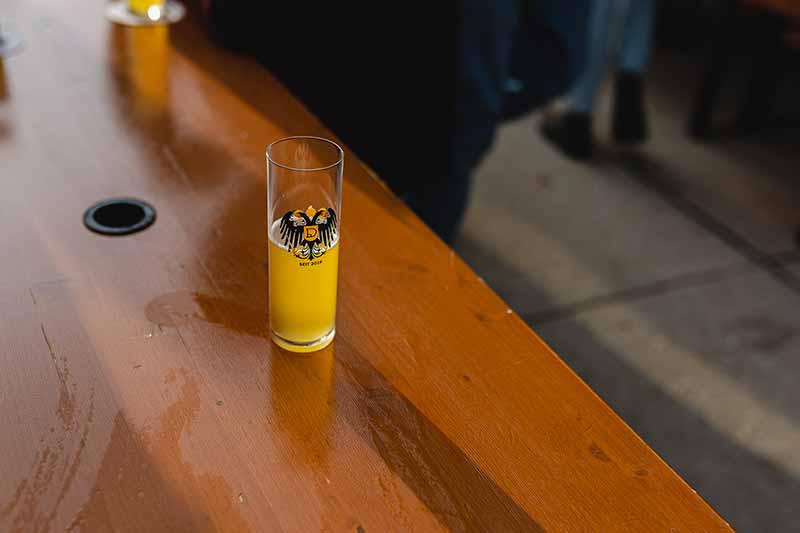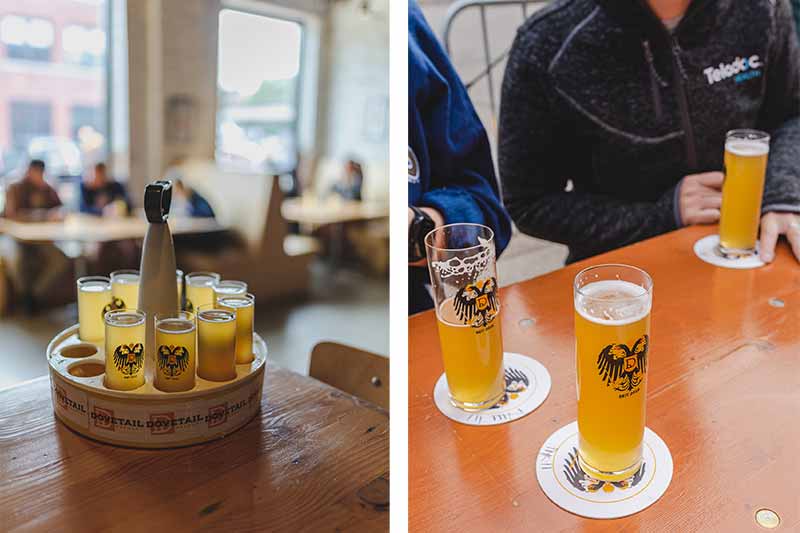
We’ve covered a number of classic old-world beer styles that originated in Germany—Märzen, helles, Berliner weisse, and schwarzbier—to name a few. With hundreds of years of history, these beers are timeless classics that remain relevant in Germany as well as craft breweries in the U.S., including the kölsch.
Kölsch is a centuries-old style that originated around Cologne (Köln), Germany. Brewers of the time would concoct light, clear, highly attenuated, and hop-accentuated top-fermented beer. The beer essentially unifies top-fermented beers with lager-style cold-conditioned bottom-fermented brews.
That’s merely a simplification of the kölsch style. We chatted with Human Robot and Dovetail Brewery, makers of great takes on the style, who shared top considerations when brewing kölsch, challenges you can run into, and how to create an ideal recipe.
(Above photography courtesy of Steph Byce | Dovetail Brewery)
What We’ll Cover in This Piece:
Affordable, Industry-Leading Brewery Software
How the Experts Define Kölsch

Photography courtesy of Steph Byce | Dovetail Brewery
The Beer Judge Certification Program describes kölsch as a very pale gold beer with little to no pilsner malt aroma and subtle fruit notes developed through fermentation. It should have a soft palate with a flavor balance of malt, hops, and yeast.
Beer styles like kölsch are right up Dovetail’s alley. Founded in 2016, the brewery brews nothing but European styles made with traditional processes—step mashing or decoction, coolship, open fermentation, horizontal lagering, etc.—so co-owner Hagen Dost knows a thing or two about the style.
Dost says they design the beer from a sense perspective, listing out the entire experience and what a consumer should feel from the second a full glass hits the table to when they take their first sip. That includes kölsch service, a traditional way of serving that includes refilling a consumer’s 200mL stange (kölsch glass) with beer until they’ve had their fill and cover their glass with a coaster.
“The appearance is straw, pale yellow with a durable stand of tight-knit white foam served in a rod-shaped glass,” he explains. “The aroma should be just slightly fruity. If it’s fresh, there will be a tiny bit of matchstick-strike sulfur, and the hop aroma will be somewhere in the spicy, floral, herbal mix that blends nicely with a very faint fruit aroma.”
Dost says the cold-fermented ale will exhibit restrained fruity yeast characteristics.
“It shouldn’t be Belgian style in its fruitiness or hefeweizen aroma. Nothing like that at all. It’s very [restrained],” Dost says. “You take a first sniff, and you could almost mistake it for a helles, but it has a distinct fruitiness.”
Dost says that when you taste the beer, it should have a pleasant softness, a soft mouthfeel, and a very light body.
“And then you’ll get a nice cracker-type maltiness, and the bitter is actually slightly assertive,” Dost says. “We look for a slightly spicy, slightly assertive bitterness that comes in three-quarters of the way on the sip.”
He adds that the beer should go down easily. The level of bitterness is slightly above a helles and definitely less than what you’d get in a pilsner.
“Lighter German pils ride the low end of the bitter,” Dost says. “This bitterness is less than that. The bitterness gives back to the depth of character to the beer. And the aftertaste should be dry and a nice long subtle bitterness.”
Dost adds, “If it’s your first beer of the day, that beer should be gone in like two minutes. And you should want another one right after it.”
Human Robot Head Brewer Andrew Foss recently visited Cologne, had an authentic kölsch, and enjoyed a full-on experience.
“Brauhaus Schreckenskammer was my favorite all-around,” says Foss, who notes in his travels, he had great kölsch at FRÜH and the Dom, too. “Schreckenskammer is a big, old-style beer hall, with an electric chain hoist that lifts the wooden casks from the basement to the bar.”
He adds, “My impression is that kölsch is a very specific beer, with less variation among producers than something like pils.”
Foss says that the textbook definition of the style calls for an emphasized fruitiness. But he was picking up something a bit different.
“It was close to an American helles,” Foss says. “It has a square mouthfeel. You can tell it is an ale, not a pronounced yeast character. It is dry and balanced with the hops. It’s very neutral.”
What Are the Top Considerations When Making Kölsch?

Photography courtesy of Human Robot
Foss points to some of the most important things to consider when brewing a kölsch.
“Fermentation is number one over any other process,” he says. “I think fermentation is the most important aspect of almost any style. For kölsch, a cool knockout at twelve degrees Celsius, and a gradual rise to eighteen [degrees] Celsius helps to keep some of the yeast character cleaner, with a slower growth than will happen at warmer temperatures.”
He adds, “Natural carbonation through a combination of spunding and krausening also help.”
Foss says typically, you step-mash when brewing a kölsch, but at Human Robot, they use a decoction method.
“It contributes to the mouthfeel,” he says.
Dost, however, believes that the step-mash is a must.
“If you’re going to do a protein rest, don’t do too long,” he says. “We rest for fifteen minutes. It would be too long if you rested for forty-five minutes to an hour.”
Dost says using only pilsner malt is important, but there’s some flexibility. He says brewers should think about what they want in the kölsch.
“We use a very small percentage of wheat malt—pale wheat—to give it a little more palate fullness,” Dost says.
Additionally, Dost says to be mindful of the pH and shoot for softer water when possible. For hops, he says to aim for bitterness that is a little heavier than the body. Like Foss, he stresses the importance of healthy yeast and pitch rates.
“Make sure it’s cool. We pitch at sixteen degrees Celsius these days,” Dost says. “And don’t let it free-rise. Control the maximum temperature.”
He adds, “Do a slight under-pitch.”
What Challenges Can You Run Into When Brewing Kölsch?

Photography courtesy of Steph Byce | Dovetail Brewery
Dost says there aren’t too many challenges when making kölsch except that they don’t re-pitch yeast.
“But that’s more because we’ve been trying to get better on re-pitching our lagers,” he says. “It’s a challenge we haven’t tackled yet.”
A kölsch should be crystal clear. Foss says one of the challenges they’ve run into at Human Robot is that the yeast is not flocculent, leaving the beer pretty hazy.
“We cold-condition it for two to three weeks, which is longer than our lagers,” Foss says. “We blend our pilsner, about five percent or whatever headspace we have, and let the yeast pull out that ale stuff.”
Foss says they’ve blended in fermenting pilsner in a few different ways. But when possible, they like to blend in about five percent of fermenting pilsner as they are cooling the kölsch down for cold conditioning.
“The lager yeast helps to form flocs in the ale yeast and lets it settle out to clarify the beer,” Foss explains. “Alternatively, we have also just racked the crashed kölsch into a lagering tank after transferring out the previous beer. We will add the kölsch through a racking arm and make sure to kick up the settled lager yeast as much as possible. Again, the lager yeast helps to clarify the kölsch yeast, which tends to stay in suspension.”
He adds, “We do that for krausening to help carbonate it and clear it out. … The addition of that yeast gives kölsch yeast something to hang onto.”
What Is an Ideal Grist for Kölsch?

Photography courtesy of Steph Byce | Dovetail Brewery
Foss says Human Robot uses one hundred percent pilsner malt and opts away from any crystal malts with intention.
“We like to control crystalizing through step mashing and decoction,” Foss says. “When you do that, you can de-nature stuff good for foam. We skip over that because of the decoction method.”
Foss adds that they mash in at sixty-two degrees Celsius and then pull about a third off to send to the kettle.
“We bring it to a boil and send it back to make the whole mash about seventy-three to seventy-five degrees Celsius,” he says. “A typical step mash would step up in temperature three to four times. We do two temperature stops.”
Dost doesn’t go entirely in on pilsner, opting for ninety-five percent pilsner and five percent pale wheat malt. Dovetail’s mash process is more traditional.
“We strike at fifty-three degrees Celsius, raise to sixty-four degrees Celsius, then raise to seventy-two degrees Celsius,” Dost says. “We rest for fifteen minutes at fifty-three, forty-five minutes at sixty-four, and then do an extended glycoprotein rest to make sure we get the good foams at seventy-two degrees Celsius.”
Which Hops and IBUs Work Best in Kölsch?
Dost references the traditional German Päffgen Kölsch, which is his favorite. He says the hops give it a peppery character. According to the brewers at Brauerei Päffgen, they use Brewer’s Gold and Aramis hops, both of English origin but similar to German Noble hops. Dost aims for a similar profile with his kölsch.
“We go for a peppery core to the bitterness,” Dost says. “We use Saaz, Saphir, and Strisselspalt [to achieve that].”
He adds, “We do three additions in a sixty-minute boil: beginning, middle, and end. Ours is twenty-four IBUs.”
Foss says they opt for Hallertau-grown Hersbrucker hops for the kölsch and most of their malt-forward beers.
“It’s a pretty neutral hop,” Foss says. “We do first wort hopping. It’s basically an even split of first wort and fifteen-minute additions. It doesn’t give too much aroma. Real kölsch doesn’t have much hop aroma.”
While they don’t send out their kölsch for testing on IBUs, they aim for somewhere between eighteen and twenty-two.
“Our pils goes out a few times a year, and we use that IBU as a hopping template and a palette calibrator,” Foss says. “Our pils sits around twenty-nine to thirty-three [IBUs].”
What Is a Great Yeast and ABV for Kölsch?

Photography courtesy of Steph Byce | Dovetail Brewery
Dovetail’s kölsch sits at 4.6% ABV, which aligns with what Dost feels is a good target for the style.
“I would say under 4.8% ABV is ideal for kölsch,” Dost says.
To get there, Dost says they use yeast isolated from the Cologne region in Germany, and they ferment between sixteen degrees Celsius and eighteen degrees Celsius.
Human Robot uses Lalleman K-97 dry yeast for their kölsch.
“We knockout at twelve degrees Celsius and settle in at about sixteen degrees Celsius,” Foss says. “It ferments in two to three days and is just at terminal, and we cool from sixteen degrees Celsius to eleven degrees Celsius.”
He adds, “That’s when we put the pilsner yeast in there to floc the kölsch yeast out.”
Foss says they sit right at 5% ABV for their kölsch, “which is pretty much what I saw when I was out there in Cologne.”
“Right around there is the sweet spot,” Foss adds.
Two Great Examples of Kölsch
Dovetail’s Kölsch is listed at 4.2% ABV and 24 IBUs. It’s an authentic take on the style, which Dost likes best about the beer.
“The best thing for me is that we’ve had a few people come in or grow up in Cologne, and the highest praise is that somebody from there says it tastes like home,” Dost says.
Human Robot has its Kölner, which sits at 5% ABV.
Foss says he tries to be as traditional as possible and get a good mouthfeel from the one hundred percent base malt.
“Getting it nice and bright with no filtration is great,” Foss says.



